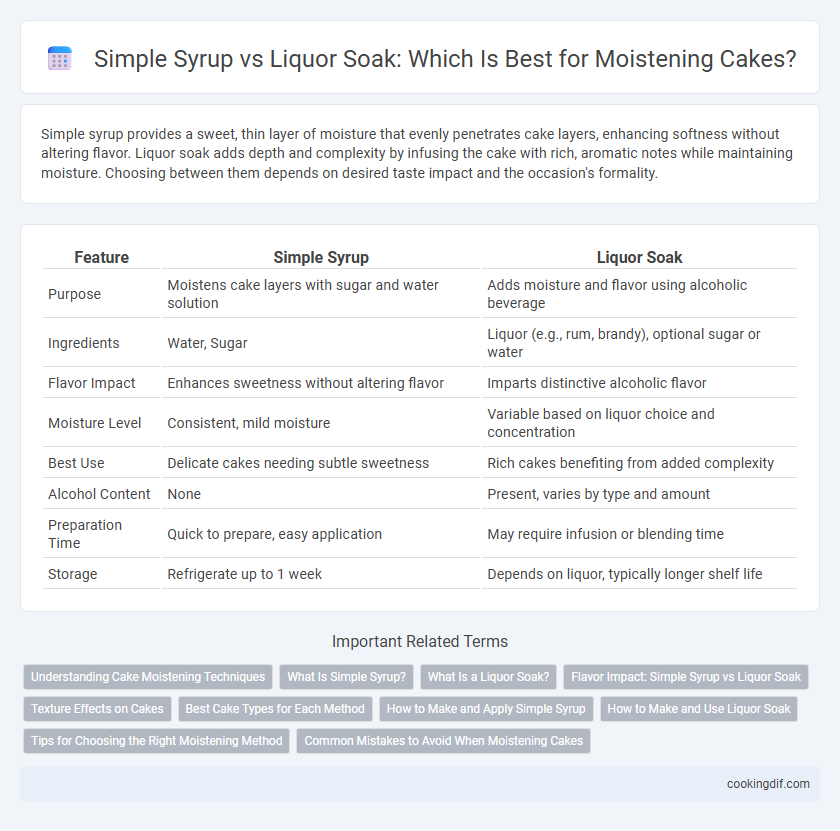Simple syrup provides a sweet, thin layer of moisture that evenly penetrates cake layers, enhancing softness without altering flavor. Liquor soak adds depth and complexity by infusing the cake with rich, aromatic notes while maintaining moisture. Choosing between them depends on desired taste impact and the occasion's formality.
Table of Comparison
| Feature | Simple Syrup | Liquor Soak |
|---|---|---|
| Purpose | Moistens cake layers with sugar and water solution | Adds moisture and flavor using alcoholic beverage |
| Ingredients | Water, Sugar | Liquor (e.g., rum, brandy), optional sugar or water |
| Flavor Impact | Enhances sweetness without altering flavor | Imparts distinctive alcoholic flavor |
| Moisture Level | Consistent, mild moisture | Variable based on liquor choice and concentration |
| Best Use | Delicate cakes needing subtle sweetness | Rich cakes benefiting from added complexity |
| Alcohol Content | None | Present, varies by type and amount |
| Preparation Time | Quick to prepare, easy application | May require infusion or blending time |
| Storage | Refrigerate up to 1 week | Depends on liquor, typically longer shelf life |
Understanding Cake Moistening Techniques
Simple syrup penetrates cake layers evenly to maintain moisture and enhance texture without overpowering the original flavors. Liquor soak adds distinct flavor profiles while moistening, ideal for complementary or rich cake recipes like fruitcakes or tiramisu. Selecting between simple syrup and liquor soak depends on the desired moisture level and flavor complexity of the final cake.
What Is Simple Syrup?
Simple syrup is a liquid mixture of sugar and water heated until the sugar dissolves, creating a sweet, easily absorbed solution used to moisten cakes. It enhances cake moisture without altering flavor, making it ideal for delicate sponge cakes or layered desserts. Unlike liquor soak, simple syrup does not add alcohol, allowing more control over sweetness and texture in baking.
What Is a Liquor Soak?
A liquor soak is a technique used to moisten cakes by soaking them in a mixture of alcohol, such as rum, whiskey, or liqueurs, often combined with sugar or flavorings. This method enhances the cake's moisture and imparts a rich, complex flavor that simple syrup cannot provide. Unlike simple syrup, which mainly adds sweetness and moisture, a liquor soak also contributes depth and warmth, making it ideal for layered or holiday cakes.
Flavor Impact: Simple Syrup vs Liquor Soak
Simple syrup enhances cake moistness by adding subtle sweetness without altering the core flavor profile, allowing the cake's natural ingredients to shine. Liquor soak introduces a more complex, layered taste, infusing the cake with rich, aromatic notes that complement and intensify the overall flavor experience. The choice between simple syrup and liquor soak depends on the desired flavor depth and balance, with simple syrup offering neutrality and liquor soak providing bold, sophisticated enhancements.
Texture Effects on Cakes
Simple syrup enhances cake moisture by penetrating crumb evenly, resulting in a tender, consistently soft texture throughout. Liquor soak adds moisture along with complex flavors but can slightly firm the crumb due to alcohol's tightening effect on gluten. Choosing simple syrup preserves delicate cake softness, while liquor soaks create a denser, more structured texture with aromatic depth.
Best Cake Types for Each Method
Simple syrup is ideal for sponge cakes, chiffon cakes, and angel food cakes due to their light, airy textures that absorb moisture well without overpowering flavor. Liquor soak enhances richer, denser cakes like fruitcakes, pound cakes, and chocolate cakes by adding depth and complexity through infused spirits such as rum, brandy, or whiskey. Choosing the right moistening method depends on balancing cake density and desired flavor impact for optimal texture and taste.
How to Make and Apply Simple Syrup
To make simple syrup, combine equal parts water and granulated sugar in a saucepan, heating gently until the sugar dissolves completely, then allow it to cool. Apply the syrup to cake layers using a pastry brush or by gently spooning it over the surface to ensure even moisture distribution without making the cake soggy. This technique enhances cake softness and extends freshness, providing a versatile alternative to liquor soak for both alcoholic and non-alcoholic cakes.
How to Make and Use Liquor Soak
To make a liquor soak, combine equal parts water and sugar in a saucepan, heating until the sugar dissolves completely before removing from heat and stirring in your choice of liquor such as rum or whiskey. Allow the mixture to cool fully before using a pastry brush to evenly apply the soak onto cake layers, ensuring deep moisture and enhanced flavor absorption. Use the liquor soak sparingly to avoid overpowering the cake, focusing on infusing richness and maintaining a moist texture.
Tips for Choosing the Right Moistening Method
Simple syrup provides controlled sweetness and moisture balance, ideal for delicate cakes like sponge or chiffon where flavor enhancement is minimal. Liquor soak adds depth and complexity, suitable for rich, dense cakes like fruitcakes or bundts that benefit from bold flavor infusion. Consider cake texture, desired flavor profile, and occasion to select between subtle hydration with simple syrup or pronounced taste enhancement through liquor soak.
Common Mistakes to Avoid When Moistening Cakes
Common mistakes to avoid when moistening cakes include using too much simple syrup, which can make the cake overly soggy and compromise its texture, or applying liquor soak unevenly, leading to inconsistent moisture distribution. Selecting the wrong concentration of syrup or alcohol can either overpower the cake's flavor or leave it dry. It's essential to measure quantities accurately and apply the soak evenly with a brush or syringe to maintain optimal moisture and taste balance.
Simple Syrup vs Liquor Soak for moistening Infographic

 cookingdif.com
cookingdif.com